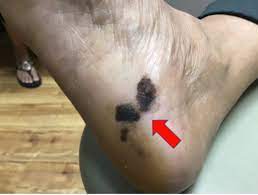
 Uncommon, atypical form of melanoma that arises on the volar and subungunal surfaces.
Uncommon, atypical form of melanoma that arises on the volar and subungunal surfaces.
Sites of involvement include palms,soles and nail beds.
Comprises only 2-10% of all melanomas.
They comprise only 1 to 2% of all melanomas in Western Caucasian populations.
Most frequent type of melanoma in in those of African, Middle Eastern, and Asian descent.
Acral melanomas predominates and accounts for approximately 40% of cases in Asian populations.
Acral melanomas comprise 40-45% of cases of melanoma in China and Japan.
Frequently misdiagnosed because of its uncommon location and lack of a changing mole.
It is molecularly distinct from cutaneous melanoma, harboring higher rates of rearrangements such as copy number gains and losses and lower rate of ultraviolet induced missense mutations and BRAF V600 alterations.
Frequently amelanotic and ulcerated.
Most common location of foot and ankle melanomas is on the plantar aspect of the foot.
Poorer prognosis for foot and ankle melanomas.
KIT mutations occur more commonly than in cutaneous melanomas 15-20% versus 1%.
BRAF mutations arise less often in acral versus cutaneous melanoma, 15% versus 45-50%.
NRAS mutations were found in cutaneous and acral melanoma with the similar incidence of 15-20%.
Presently the addition of targeted therapies and immunotherapy have altered treatment practice.
Ipilimumab is an active agent in acral melanoma.
Overall responds great to immune checkpoint blockade is 32%, similar or slightly lower than that seem in cutaneous melanoma.
BRAF mutations only occur in 10 to 22% of patients with acral melanomas, and KRAS 9 to 28% limiting the use of targeted agents.
KIT variants are found in mucosal, and a acral melanomas, but have a low frequency of 10 to 20% and KIT inhibitors only have limited activity.
